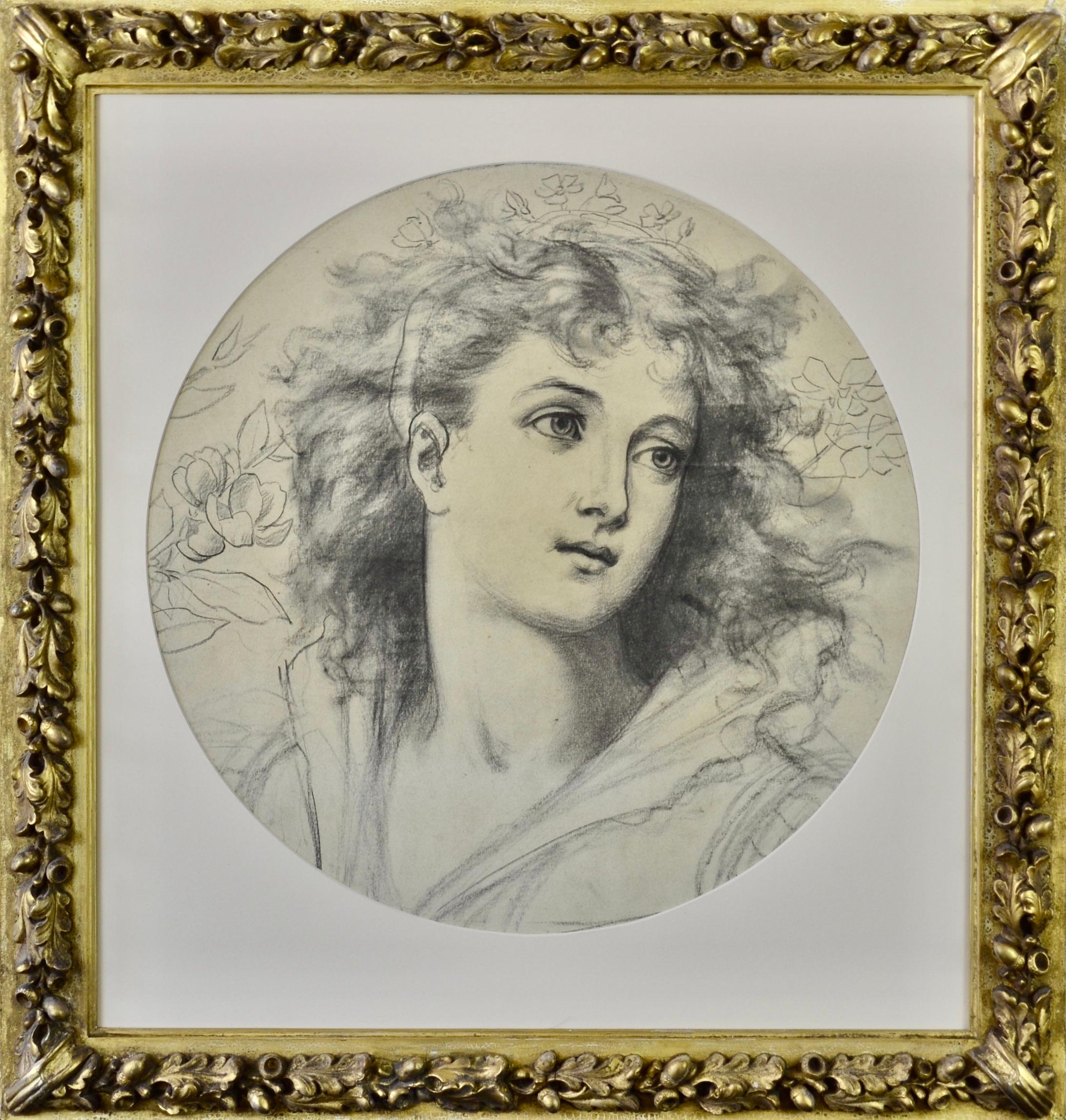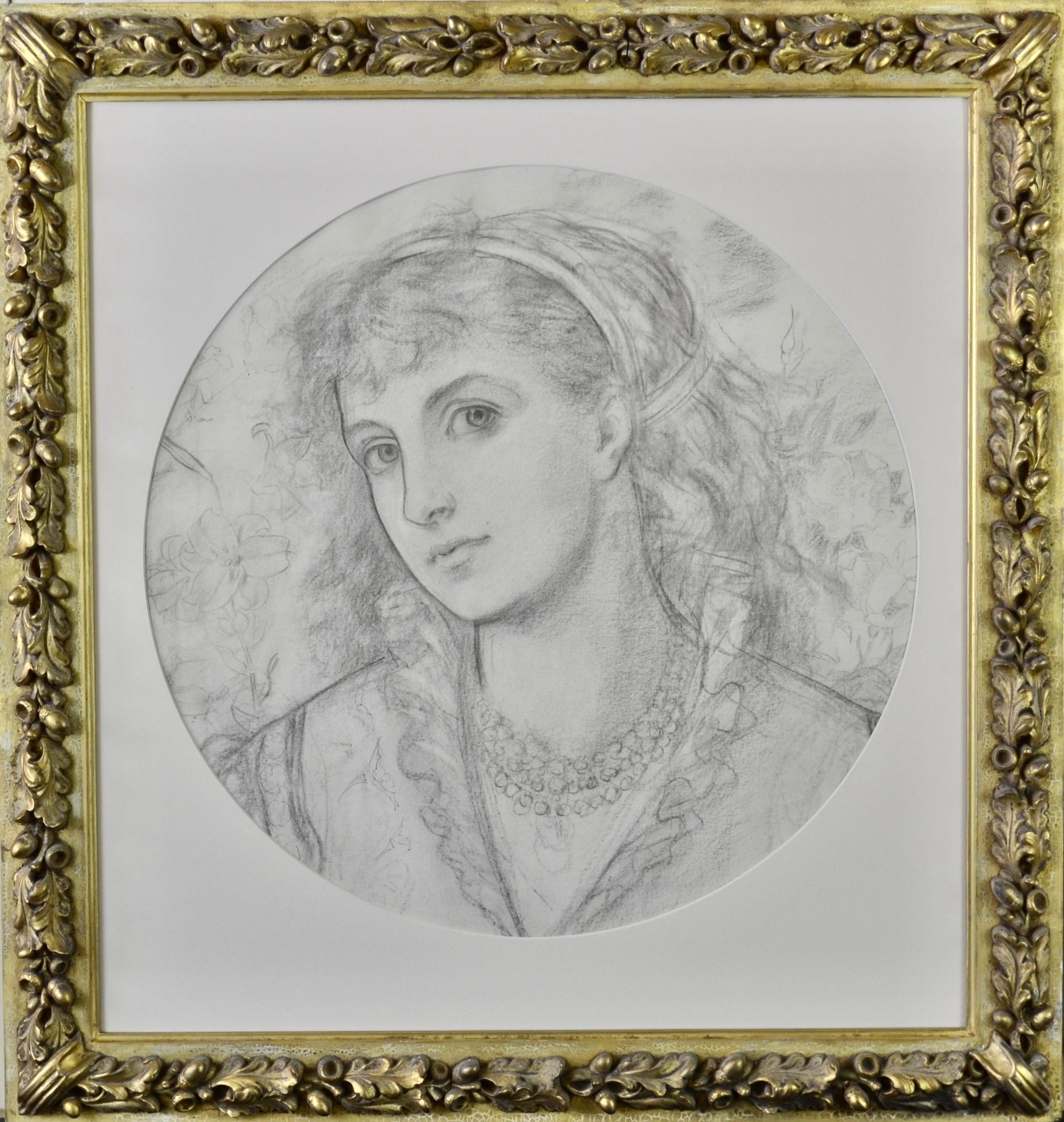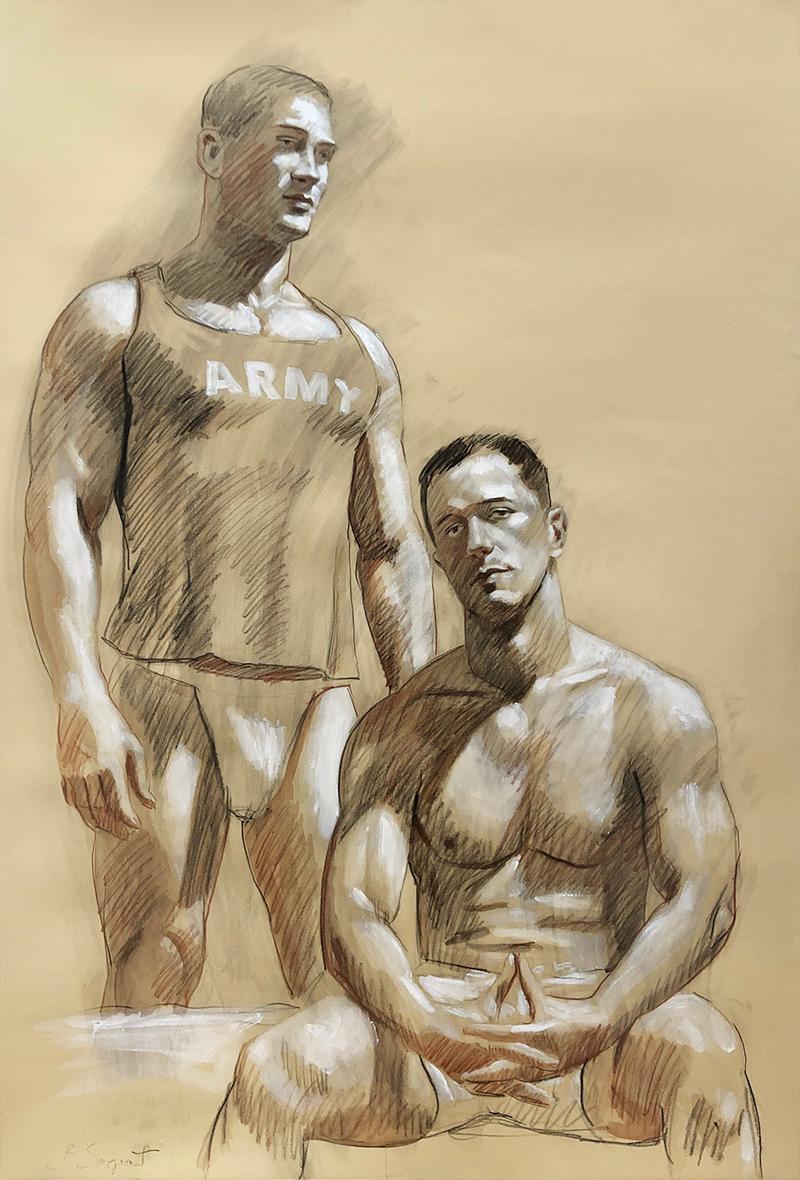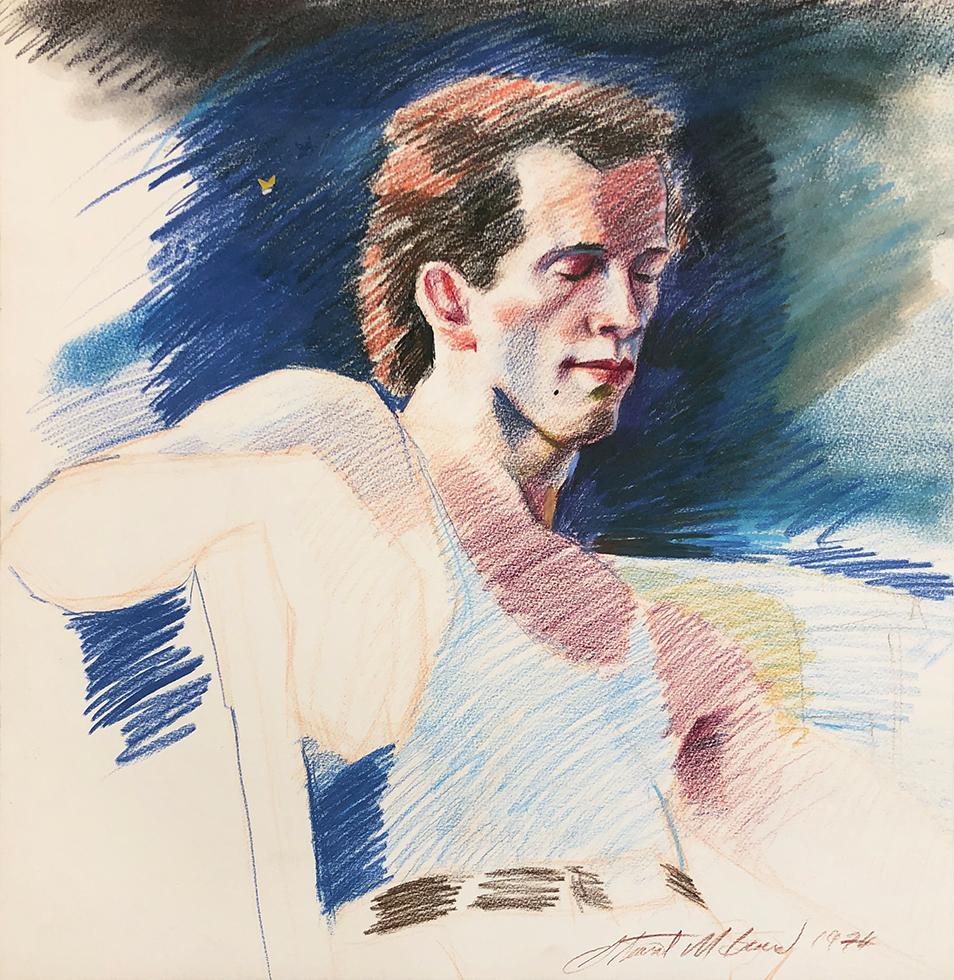Items Similar to Sketch of a head - Carved in stone -
Want more images or videos?
Request additional images or videos from the seller
Emil FaeschSketch of a head - Carved in stone -1888
1888
About the Item
Emil Faesch (1865 Basel - 1915 Basel). Sketch of a head. Charcoal on painting cardboard, 60 x 47.5 cm (folio size), signed and dated at lower right "E. Faesch. 1888.".
Minor browning.
- Carved in stone -
About the artwork
The life-size head has an immensely present presence. This effect is due to the fact that Faesch took his cue from academic classical busts, but made the head naturalistic, right down to the eyelashes and the folds of the eyelids, thus breaking through the distance of classical ideality and creating an immediacy. Paradoxically, the liveliness thus achieved culminates in the fact that the sitter appears to have exhaled the breath of life. The present presence is thus transferred back to the eternity of the stone, in whose specific materiality the face and especially the hair shimmer, while the upper part of the body clearly exposes the stone.
The architect Emil Faesch, who was initially trained as a draughtsman and modeller and would continue to practise this profession as a teacher at the Gewerbeschule Basel, has here created an impressive reinterpretation of the academic study head, into which he breathes new life, while at the same time surrounding it with the breath of death.
About the artist
Emil Faesch was a member of the famous Faesch family of Basel goldsmiths. At an early age, the artistically gifted Faesch attended the Basel School of Drawing and Modelling, where he studied under Fritz Schider. After an apprenticeship at the architectural firm of Vischer & Fürter, he continued his training as an architect by studying at the Technical University of Munich under August and Friedrich Thiersch. In 1892 he was appointed curator at the Gewerbemuseum in Basel. From 1893 he taught at the associated Gewerbeschule. In 1897 he resigned to work as a freelance architect.
Faesch built many public buildings that shaped the cityscape, as well as bridges. These include the prominent Mittlere Rheinbrücke in Basel.
Selected bibliography
Saur, Allgemeines Künstlerlexikon. Die bildenden Künstler aller Zeiten und Völker, vol. 36, p. 192.
GERMAN VERSION
Emil Faesch (1865 Basel - 1915 Basel). Studienkopf. Kohle auf Malkarton, 60 x 47,5 cm (Blattmaß), rechts unten signiert und datiert „E. Faesch. 1888.“.
Minimal braunfleckig.
- In Stein gemeißelt -
zum Werk
Der lebensgroße Kopf entfaltet eine ungemein gegenwärtige Präsenz. Diese Wirkung resultiert daraus, dass sich Faesch an akademisch-klassizistischen Büsten orientiert, den Kopf jedoch bis in die Wimpern und die Augenliedfalten hinein naturalistisch ausformt, wodurch die Distanz der klassizistischen Idealität auf eine Unmittelbarkeit hin durchbrochen wird. Die damit erzielte Lebendigkeit kulminiert paradoxerweise gerade darin, dass der Dargestellte offensichtlich den Lebensatem ausgehaucht hat. Dadurch wird die gegenwärtige Präsenz wieder in die Ewigkeit des Steins überführt, in dessen spezifischer Materialität das Antlitz und insbesondere des Haare aufschimmern, während der Oberkörper den Stein deutlich ausstellt.
Der zunächst als Zeichner und Modellierer ausgebildete Architekt Emil Faesch, den dieses Metier im Rahmen seiner Tätigkeit als Lehrer der Gewerbeschule Basel auch weiterhin beschäftigen sollte, hat hier eine beeindruckende Neuinterpretation des akademischen Studienkopfes geschaffen, dem er neues Lebens einhaucht, wodurch ihn zugleich der Hauch des Todes umgibt.
zum Künstler
Emil Faesch entstammt der berühmten Basler Goldschmiede-Familie Faesch. Bereits in jungen Jahren besucht der künstlerisch begabte Faesch die Basler Zeichen- und Modellierschule, wo er bei Fritz Schider lernt. Nach einer Lehre im Architekturbüro Vischer & Fuerter, setzt er seine Ausbildung als Architekt mit einem Studium an der TH München bei August und Friedrich Thiersch fort. 1892 erfolgt eine Berufung als Konservator an das Basler Gewerbemuseum. Ab 1893 unterrichtet er an der angegliederten Gewerbeschule. 1897 tritt er von seinen Ämter zurück, um sich fortan als freier Architekt zu betätigen.
Faesch errichte zahlreiche das Stadtbild prägende öffentlichen Gebäude, aber auch Brückenbauten. Darunter die prominente Mittlere Rheinbrücke in Basel.
Auswahlbibliographie
Saur allgemeines Künstlerlexikon. Die bildenden Künstler aller Zeiten und Völker, Bd. 36, S. 192.
- Creator:Emil Faesch (1865 - 1915, Swiss)
- Creation Year:1888
- Dimensions:Height: 23.63 in (60 cm)Width: 18.9 in (48 cm)Depth: 0.4 in (1 cm)
- Medium:
- Movement & Style:
- Period:
- Condition:
- Gallery Location:Berlin, DE
- Reference Number:1stDibs: LU2438212326132

About the Seller
5.0
Vetted Seller
These experienced sellers undergo a comprehensive evaluation by our team of in-house experts.
Established in 2014
1stDibs seller since 2023
7 sales on 1stDibs
Typical response time: 6 hours
- ShippingRetrieving quote...Ships From: Berlin, Germany
- Return PolicyA return for this item may be initiated within 14 days of delivery.
More From This SellerView All
- Half-length portrait of a Pharisee - In the shadow of betrayal -Located in Berlin, DEHermann Prell (1854 Leipzig - 1922 Dresden-Loschwitz). Half-length portrait of a Pharisee, 1885. Sketch for the right-hand figure in the painting Judas Iscariot, 1886. Pencil drawing heightened with opaque white and black chalk on beige-grey wove paper (papier vélin), 34 x 27.8 cm (visible size), 52 x 45 cm (mount), signed, dated and inscribed "H. PRELL 1885 zu 'Judas'". Minor browning, collection stamp on the reverse. - In the shadow of betrayal - About the artwork This painting is the sketch for the head of the Pharisee offering the coins to Judas in one of Herrmann Prell's major works, the painting Betrayal of Judas, completed in 1886. The painting belongs to the Staatliche Kunstsammlungen Dresden and is illustrated in Adolf Rosenberg: Prell, Bielefeld and Leipzig 1901, p. 21 (Fig. 19). It is especially highlighted in Thieme-Becker (vol. 27, p. 376). Hermann Prell, Betrayal of Judas, 1886 The monumental head, which fills the picture and is distinguished by its ornamented robe, is almost a lost profile, which in the executed painting is justified by the Pharisee's turning towards Judas. Despite the fact that the sitter withdraws from the viewer by turning away, it was necessary to artistically elaborate the motivation for the purchase of one of Christ's disciples, which is why the drawing focuses on the expression of the face, while the 'accessories' are treated in a more summary manner. In characterising the face, Hermann Prell performs a balancing act: since the Pharisee, despite his destructive actions, is an actor in the history of salvation, the head must show a dignity appropriate to the event, but at the same time the physiognomy must also bear witness to the scheming attitude that led to the betrayal. To solve this dilemma, Prell draws on the traditional depictions of the heads of the apostles, shading the face to indicate the obdurate darkness of the spirit and moving the base of the nose slightly upwards while the mouth falls away, thus giving a physiognomic expression to the motivation of the action. The fatal drama of the betrayal is expressed in the monumentalisation of the head and in the thunderous white highlights that contrast with the darkness of the chalk. As a study, considered by the artist to be a work in itself, this drawing reveals the pictorial problems and brainstorming of monumental painting. About the artist In 1872 Prell, who was one of the most important exponents of monumental painting of his time, began studying painting with Theodor Grosse at the Dresden Academy of Art and continued with Carl Gussow at the Berlin Academy in 1876. Hans von Marées taught him in Rome in 1878. More influential on his work, however, were Arnold Böcklin and Max Klinger, with whom Prell had been friends since his student days and with whom he worked together on several occasions. Prell's first major work, which established his reputation as a monumental painter, were the frescoes in the banqueting hall of the Architektenhaus in Berlin in 1881/82, commissioned by the state and depicting the different periods of architecture. Prell then went to Italy for two years to study fresco painting. Other major commissions followed. These included monumental frescoes in the town halls of Worms (1884), Hildesheim (1882-92), Gdansk (1895) and Dresden, the staircase of the Silesian Museum of Fine Arts in Breslau (1893/94), the throne room of the German Embassy in Rome (1896-99) and the staircase of the Albertinum in Dresden (1900-1904). From 1886 Prell taught at the academy of arts in Berlin and in 1892 he was appointed professor at the academy of arts in Dresden. His students included Osmar Schindler and Hans Unger...Category
1880s Realist Figurative Drawings and Watercolors
MaterialsChalk
- Man sitting in the studio - Thinking about art -Located in Berlin, DEAdolph Eduard Otto von Faber du Faur (1828 Ludwigsburg - 1901 Munich). Man sitting in the studio. Watercolour painting, 43 x 27 cm (visible size), 73 x 53 cm (frame), monogrammed at lower right, estate stamp. Upper right corner neatly repaired, small tear in the wall to the left of the sitter. - Thinking about art - About the artwork The sitter, an elderly man, is seated in a studio on a pedestal reminiscent of an academy hall. The earthy, dark tones give the scene a weighty quality. The lightest tones are found in the incarnate parts of the figure, which do not stand out from the other colours of the picture, but are linked to them. As a result, the sitter's face is both part of and the highlight of the colour references in the picture. The colour of the sitter's skin is reflected in his pink coat, while his white-grey hair matches the colour of the wall next to him. This almost monochrome wall surface, in turn, is connected across the portrait to the framed picture standing on the floor, which seems to have been erased by this correspondence with the empty wall surface. Through the palette, which is positioned directly behind the sitter's head, the reference to painting, which is already given by the studio space, is explicitly linked to the sitter, who thus seems to be contemplating the question of the meaning of art. This raises the question of whether Faber Du Faur, who had become lonely in his old age, might have painted a self-portrait here in his later years. In addition to the studio setting, the sitter's explicit reference to the palette and the fact that the picture was part of his estate, the only summary elaboration of the body suggests a self-portrait, while the representation of the face is concretised with the wide-open eyes typical of a self-portrait. This concentration on the face gives the impression of the artist's melancholy introspection, captured by the palette and related to the meaning of painting, whose dark character is reinforced by the concealment of the palette hanging on the right of the picture in the light tones so characteristic of Faber Du Faur. In the course of this resignation, Faber du Faur advises his son Hans, who has also become a painter: "Promise me one thing: never move to Munich, they'll kill you here!" Whoever the sitter may be, the references to painting make the portrait a resigned self-contemplation by Faber Du Faur, focused on art. About the artist After leaving school, Otto Faber du Faur entered the service of the Württemberg army, at the same time cultivating his artistic talent. In 1851, on the recommendation of his father Christian Wilhelm, who was himself a battle painter, he spent six months in Munich as an apprentice to Alexander von Kotzebue. In 1852 he was granted a year's leave of absence from military service to study battle painting in the studio of Adolphe Yvon...Category
1890s Realist Portrait Drawings and Watercolors
MaterialsWatercolor
- High Moorland Landscape in the fog - The world as a transcendent phenomenon -Located in Berlin, DECharles Edward Brittan Jr (1870 Plymouth - 1949). High moor landscape in the fog. Gouache, signed at lower left "Charles E. Brittan", 18 x 34.5 cm (passepartout), 45 x 62 cm (frame)....Category
Early 20th Century Realist Landscape Drawings and Watercolors
MaterialsWatercolor
- Study with Torso, Hands, and Umbrella - The characteristic of the inconspicuousLocated in Berlin, DEPaul Friedrich Meyerheim (1842 Berlin - 1915 ibid.). Sketch of a female torso with hands and an umbrella. Pencil on paper, 27.5 x 22.5 cm (visible size)...Category
1890s Realist Figurative Drawings and Watercolors
MaterialsPencil
- Self-portrait - Homo nudus -Located in Berlin, DEBruno Paul (1874 Seifhennersdorf - 1968 Berlin). Self-portrait, c. 1895. Pencil on paper, mounted on cardboard, 53.5 x 35 cm, signed 'Paul' at upper left. - Homo nudus - About the artwork In a mirrored situation, Bruno Paul looks at himself in the picture. While his body, which is the size of the format, is shown in profile parallel to the picture, he turns his head into the picture in order to become aware of himself there, whereby the lighter use...Category
1890s Realist Figurative Drawings and Watercolors
MaterialsPencil
- Red blooming war landscape with dead soldier - Bleeding flowers -Located in Berlin, DEJohannes Friedrich Heinrich Hänsch (1875-1945), Red blooming war landscape with dead soldier, 1918. Watercolor and gouache on paper, 15 x 24.5 cm (image), 27 x 37 cm (sheet size / frame), monogrammed and dated "19JH18" at lower left. - Paper slightly darkened About the artwork Despite the relatively small format, the watercolor with an internal frame depicts a panoramic view of a flat landscape stretching to the horizon. As far as the eye can see, the poppies bloom in flaming red. The flowers are not rendered individually, however, creating an almost cohesive red surface. The bright red is interspersed with vegetal green. A complementary contrast that creates an intense color effect. In this color contrast, a white area breaks through from the middle ground, widening towards the foreground and surrounding a brown hole. Next to it, in blue, is the actual protagonist of the painting, the first thing that catches the eye: a dead soldier. Next to him is his helmet, revealing the empty interior. The brown, hollow shape corresponds to the hole in the ground. A shell funnel is surrounded by bright ash, which, like the inverted helmet, becomes a sign of death. The soldier's arms point to the funnel, while the empty helmet paraphrases the calotte of the skull and, like the funnel, thematizes the empty darkness of death. The soldier's body, however, is intact and not - as in Otto Dix's triptych "The War" - a dismembered corpse. Instead, Johannes Hänsch activates the landscape, especially the color, to illustrate a blooming landscape of death that extends from the shell funnel in the foreground to the rising column of smoke on the horizon. If the soldier's body is intact, the tangle of barbed wire emblematically placed over the empty helmet also appears tattered. On the right side of the picture, the barbed wire even seems to stretch its arms to the sky in horror. Against the background of this allegory, the content of the bright red also becomes clear: the landscape is drenched in blood, literally a sea of blood, and the single unknown soldier stands pars pro toto for all those who died on the battlefield. Dying in war is not dying in community, but in solitude. In order to emphasize the isolation in death, Johannes Hänsch has set the blue of the soldier in the axis given by his body in the middle ground of the picture into the red sea. A master of landscape painting, Hänsch succeeds in creating a natural-looking landscape allegory that illustrates the horror and death of war, without depicting the brutality of war itself. This singular 'war memorial' of the unknown soldier is the opposite of heroization and yet the dignity of the deceased soldier is preserved through the integrity of his body. About the artist As the son of the sculptor Adolf Haensch, the young Johannes received his first artistic training in his father's Berlin studio. However, he eventually decided to become a painter, and in 1897 he entered the Berlin Academy of Arts. He initially studied under Paul Vorgang and Eugen Bracht, and was particularly influenced by Bracht's increasingly colourful landscape painting. In 1901 he moved to the class of Friedrich Kallmorgen, with whom he spent several weeks on excursions into nature. In 1905 he became a master pupil of Albert Hertel, who taught him watercolour painting. From 1903 to 1933 he exhibited annually at the Great Berlin Art Exhibition, the exhibitions of the Berlin Artists' Association and the Munich Glaspalast. In 1905 he was awarded the Carl Blechen...Category
1910s Realist Figurative Drawings and Watercolors
MaterialsWatercolor
You May Also Like
- Spring - Chalk design drawing for a Minton plaque by Herbert Wilson FosterBy Herbert Wilson FosterLocated in London, GBHERBERT WILSON FOSTER (1846-1929) Spring Inscribed with title beneath the mount Chalk, circular Framed Diameter 42 cm., 16 ½ in. (frame size 61 by 58 cm., 24 by 22 ¾ in.) Herbert Wilson Foster was born in Endon, Staffordshire. He attended Hanley School of Art before continuing his studies in London, Belgium and France. His paintings of rural and domestic subjects were exhibited at the Royal Academy between 1873 and 1899. In 1893 he accepted a teaching position at the Nottingham School of Art, where his pupils included Laura Knight and Harold Knight. Works by him are in the collections of the Minton archives; the Wisbech & Fenland Museum; Leicester Art Gallery; Rushcliffe Council and Nottingham Castle Museum. In addition to his work as a painter he worked as a porcelain painter, working at one point on the tile panels in the Victoria & Albert Museum. He is known to have worked at Mintons from 1872 where he specialized in portraits of contemporary personalities, including members of the Royal Family. This head of a girl was probably intended for a painted ceramic wall charger...Category
1870s Realist Figurative Drawings and Watercolors
MaterialsPencil, Chalk
- Summer - Chalk Drawing Design for Minton charger by Herbert Wilson FosterBy Herbert Wilson FosterLocated in London, GBHERBERT WILSON FOSTER (1846-1929) Summer Inscribed with title beneath the mount Chalk, circular Framed Diameter 42 cm., 16 ½ in. (frame size 61 by 58 cm., 24 by 22 ¾ in.) Herbert Wilson Foster was born in Endon, Staffordshire. He attended Hanley School of Art before continuing his studies in London, Belgium and France. His paintings of rural and domestic subjects were exhibited at the Royal Academy between 1873 and 1899. In 1893 he accepted a teaching position at the Nottingham School of Art, where his pupils included Laura Knight and Harold Knight. Works by him are in the collections of the Minton archives; the Wisbech & Fenland Museum; Leicester Art Gallery; Rushcliffe Council and Nottingham Castle Museum. In addition to his work as a painter he worked as a porcelain painter, working at one point on the tile panels in the Victoria & Albert Museum. He is known to have worked at Mintons from 1872 where he specialized in portraits of contemporary personalities, including members of the Royal Family. This head of a girl was probably intended for a painted ceramic wall charger...Category
1870s Realist Figurative Drawings and Watercolors
MaterialsPencil, Chalk
- Two MenBy Mark BeardLocated in New York, NYCharcoal with red and white conté crayon on Rives BFK paper Signed in pencil, l.l. This artwork is offered by ClampArt, located in New York City. Mark Beard, born in 1956 in Salt L...Category
21st Century and Contemporary Realist Figurative Drawings and Watercolors
MaterialsConté, Paper, Charcoal
- Untitled (Man Reclining on Tile Floor)By Mark BeardLocated in New York, NYGraphite and conté crayon on paper Signed and dated, l.r. This artwork is offered by ClampArt, located in New York City. Mark Beard, born in 1956 in Salt Lake City, now lives in Ne...Category
1970s Realist Figurative Drawings and Watercolors
MaterialsPaper, Graphite, Conté
- Untitled (Man Reading Newspaper)By Mark BeardLocated in New York, NYConté crayon on paper Signed, l.r. This artwork is offered by ClampArt, located in New York City. Mark Beard, born in 1956 in Salt Lake City, now lives in New York City. His works ...Category
1970s Realist Figurative Drawings and Watercolors
MaterialsConté, Paper
- Untitled (Man in Blue Tank Top)By Mark BeardLocated in New York, NYPastel and conté crayon with partial foil star on Rives BFK paper Signed and dated, l.r. This artwork is offered by ClampArt, located in New York City. Mark Beard, born in 1956 in ...Category
1970s Realist Portrait Drawings and Watercolors
MaterialsFoil
Recently Viewed
View AllMore Ways To Browse
Lehrer Artist
Marguerite Callet-Carcano On Sale
Maurice Berdon On Sale
Augusta Hoffman Studio
Augusta Hoffman
Bar Cart Nyc
Blue Milk Paint Farm Table
Bo Bartlett On Sale
Broncia Koller
Bror Julius Olsson Nordfeldt On Sale
Buford Crossland
C. Harry Allis On Sale
Cecil Wray Goodchild
Charles Paul Gruppe On Sale
Chinese Figurative Rug
Claudio Bravo Pencil
Concetta Scaravaglione
Constantin Ernest Adolphe Hyacinthe Guys On Sale





